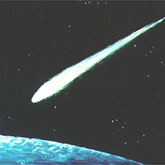Look, Up in the Sky. It's A Bird. No It's A Meteorite!

While the return of the swallows is eagerly anticipated and eyes are directed skyward for the first sighting there may be some eyes watching for more than the return of birds. This could be because thirty years ago, late in the evening of March 15th 1973, a small rock smashed through the aluminum roof of a carport in San Juan Capistrano. This rock, a meteorite, was named the San Juan Meteorite. Interestingly it was not only seen falling but was also quickly recovered and put in the hands of scientists at the University of Southern California, San Diego. There it was identified as a chrondrite, one of three categories that meteorites are grouped into based on their composition. Meteorites, like the SJC Meteorite are fragments of rocky material that originally were part of an asteroid. These meteorites are important in that they are relatively pristine remnants of the early stages of the formation of our solar system.
About the Author
Bob Riddle
 Bob Riddle lives in Lee's Summit Missouri and is adjunct faculty at Longview
Community College and Avila University where he teaches Astronomy and
Physical Science in the clasroom as well as online. He maintains 'Que tal in the Current Skies', an Astronomy website, and is the column editor for 'Scope on the Skies', a regular feature of Science Scope Magazine, the National Science Teachers Association middle school journal.
Bob Riddle lives in Lee's Summit Missouri and is adjunct faculty at Longview
Community College and Avila University where he teaches Astronomy and
Physical Science in the clasroom as well as online. He maintains 'Que tal in the Current Skies', an Astronomy website, and is the column editor for 'Scope on the Skies', a regular feature of Science Scope Magazine, the National Science Teachers Association middle school journal.


